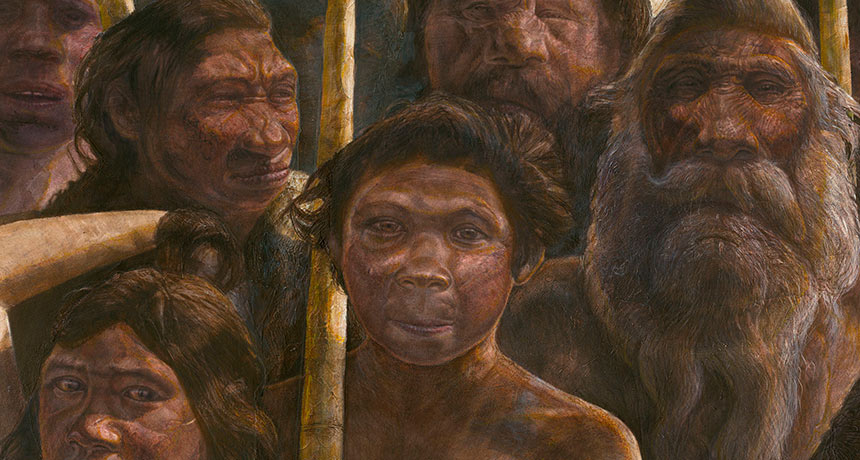Ancient DNA reveals who is in Spain’s ‘pit of bones’ cave
Finding points to Neandertals living in Europe 430,000 years ago

NEANDERTALS ARE US Newly recovered DNA suggests that hominid fossils previously found in a Spanish cave come from Neandertals who lived around 430,000 years ago.
Kennis & Kennis/MADRID SCIENTIFIC FILMS
Neandertals hung out in what’s now northern Spain around 430,000 years ago, an analysis of ancient DNA suggests. That’s an earlier Neandertal presence in Europe, by at least 30,000 years, than many researchers had assumed.
Fragments of nuclear DNA from a tooth and partial leg bone discovered at Sima de los Huesos, a chamber deep inside a Spanish cave, resemble corresponding parts of a previously reassembled Neandertal genome, researchers say in a study published online March 14 in Nature.
Not much nuclear DNA survives in such ancient fossils, say paleogeneticist Matthias Meyer of the Max Planck Institute for Evolutionary Anthropology in Leipzig, Germany, and his colleagues. Meyer’s group recovered DNA fragments covering a fraction of 1 percent of the newly recovered Neandertal tooth and leg genomes. Just enough DNA remained to enable comparisons with DNA of a Neandertal woman (SN: 1/25/14, p. 17) and a Denisovan woman (SN: 9/22/12, p. 5). Denisovans are considered close genetic cousins of Neandertals.
The early age for the new genetic finds challenges the idea that fossils from Sima de los Huesos, or pit of bones, come from a species called Homo heidelbergensis. Some researchers have suspected that by around 400,000 years ago, H. heidelbergensis gave rise to evolutionary precursors of both Neandertals and Homo sapiens.

An ancient genetic puzzle has also emerged at Sima de los Huesos. On one hand, nuclear DNA — which passes from both parents to their children — pegs the Spanish hominids as Neandertals. But mitochondrial DNA — typically inherited only from the mother — already extracted from one Sima de los Huesos fossil (SN: 12/28/13, p. 8) and described for a second fossil in the new study has more in common with Denisovans.
Denisovans lived in East Asia at least 44,000 years ago, but their evolutionary history is unknown.
If early Neandertals lived in northern Spain roughly 430,000 years ago, “we have to go back further in time to reach the common ancestor of Neandertals and Denisovans,” Meyer says.
The new genetic data from Sima de los Huesos now suggest that Denisovans split from Neandertals perhaps 450,000 years ago, says paleoanthropologist Chris Stringer of the Natural History Museum in London. Genetic and fossil evidence point to Neandertals and H. sapiens diverging from a common ancestor around 650,000 years ago, he proposes.
But it’s hard to say whether that common ancestor was H. heidelbergensis, Stringer adds. “Research must refocus on fossils from 400,000 to 800,000 years ago to determine which ones might lie on ancestral lineages of Neandertals, Denisovans and modern humans.”
Hominids throughout Eurasia during that time may have shared a mitochondrial DNA pattern observed in Sima de los Huesos Neandertals and Asian Denisovans, Meyer suggests. If that was the case, Neandertals acquired a new form of mitochondrial DNA by interbreeding with modern humans or their direct ancestors from Africa sometime between 430,000 and 100,000 years ago (SN: 3/19/16, p. 6).
Another possibility is that Neandertals traveled to Europe from Asia more than 430,000 years ago, carrying Denisovan mitochondrial DNA with them, says paleogeneticist Carles Lalueza-Fox of the Institute of Evolutionary Biology in Barcelona. Or hybrid descendants of early Neandertals and early Denisovans may have lived at Sima de los Huesos, carrying Denisovan mitochondrial DNA, he speculates.
“We really need more genetic data from Sima de los Huesos, and other sites of that age, to narrow down these scenarios,” Meyer says.







